From Safest to Most Dangerous: Arrest Rates at Football Stadiums in the UK

Football stadiums are like cathedrals for worshipping the beautiful game. Throughout the season, thousands of fans gather across the UK to watch their teams in action. But, not too long ago, football stadiums in the UK had a rough reputation. People knew them as dangerous places, filled with hooliganism and fan violence.
While football violence is still an issue in some parts of the world, the UK’s football stadiums are much safer today. This change is thanks to better policing, strict punishments, and increased security by professionally trained security guards holding their SIA licence.
However, not all troublemakers are gone. Disruptions and violence can still flare up, especially when emotions run high during a match. Feeling safe at the game is crucial, whether you’re with family, friends, or attending alone. That’s why we’ve reviewed police data to identify the safest and most dangerous football stadiums in the country.
Safest Football Stadiums in The UK
Pirelli and Exercise Stadiums Crowned the Safest with 0 Arrests per 10,000 Supporters
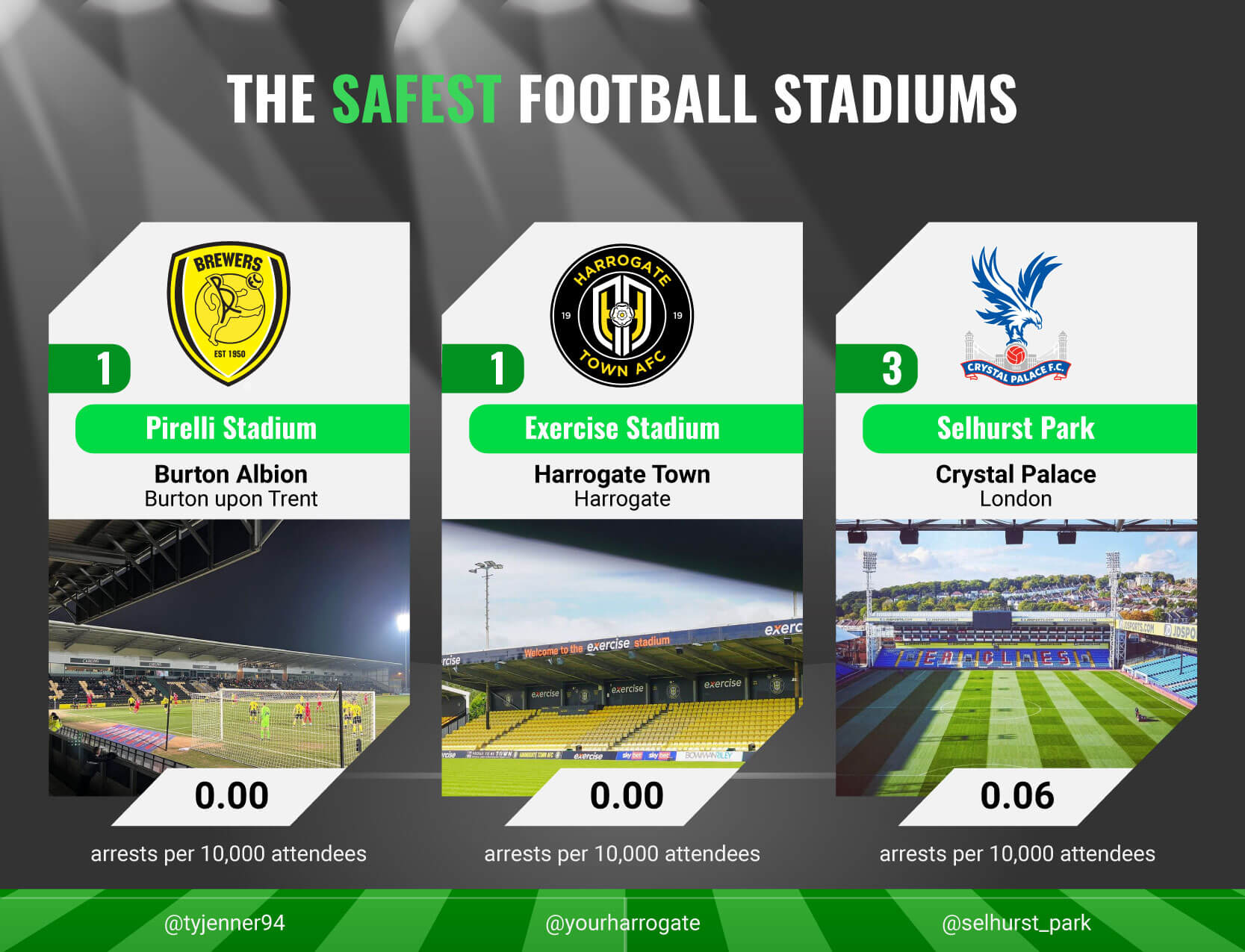
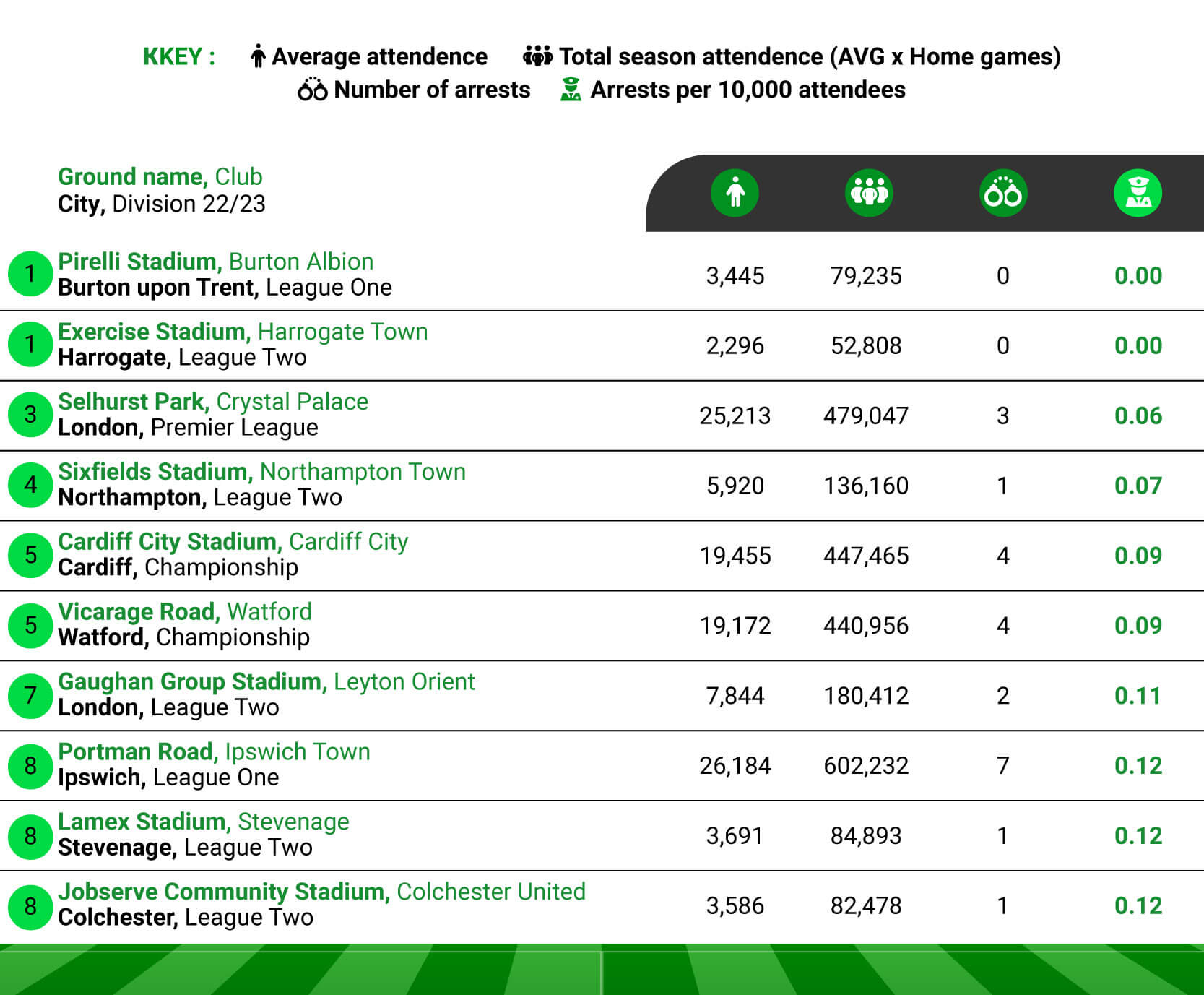
Pirelli Stadium (Burton Albion) and Exercise Stadium (Harrogate Town) - 0 Arrests per 10,000 Supporters
Two football stadiums are jointly the safest in the UK, with zero arrests recorded during the 2022/23 season at Pirelli Stadium and Exercise Stadium.
Pirelli Stadium, home of Burton Albion, has consistently outperformed expectations in recent years. The stadium, built in 2005, has a capacity of just under 7,000, averaging around half that during the 2022/23 season.
Exercise Stadium, also known as Wetherby Road, celebrated its 100th birthday in 2020. The stadium, which has been home to Harrogate Town for many years, was recently renovated to meet football league regulations upon their promotion.
The low number of arrests at these venues is a testament to effective security measures, including the work of SIA-approved security guards and door supervisors, who help ensure that fans enjoy the match in a safe and secure environment. Their presence and professionalism contribute significantly to maintaining order and preventing incidents.
Selhurst Park (Crystal Palace) - 0.06 Arrests per 10,000 Supporters
Many people are familiar with Selhurst Park, not only because it has hosted Premier League matches for many years but also as the home of the fictional AFC Richmond in the comedy show Ted Lasso.
Selhurst Park had an average crowd of just over 25,000 in the 2022/23 season, and during that time, there were three arrests. This equates to only 0.06 arrests per 10,000 supporters on average, making it one of the safest football grounds in the UK.
Sixfields Stadium (Northampton Town) - 0.07 Arrests per 10,000 Supporters
Sixfields is an area of Northampton where the football club is based. It has been home to Northampton Town since 1994. In that time, the Cobblers have mainly played in the third and fourth divisions.
In the 2023/24 season, they found themselves in League Two, finishing in third place and earning promotion to League One. The good feeling on the pitch was mirrored in the stands, with just one arrest — roughly 0.07 per 10,000 supporters, contributing to its status as one of the safest football stadiums in the UK.
Most Supported Teams With The Lowest Arrest Rates
Out of the Top 25 Most Supported Teams, Selhurst Park Had the Fewest Arrests at 0.06 per 10,000 Supporters
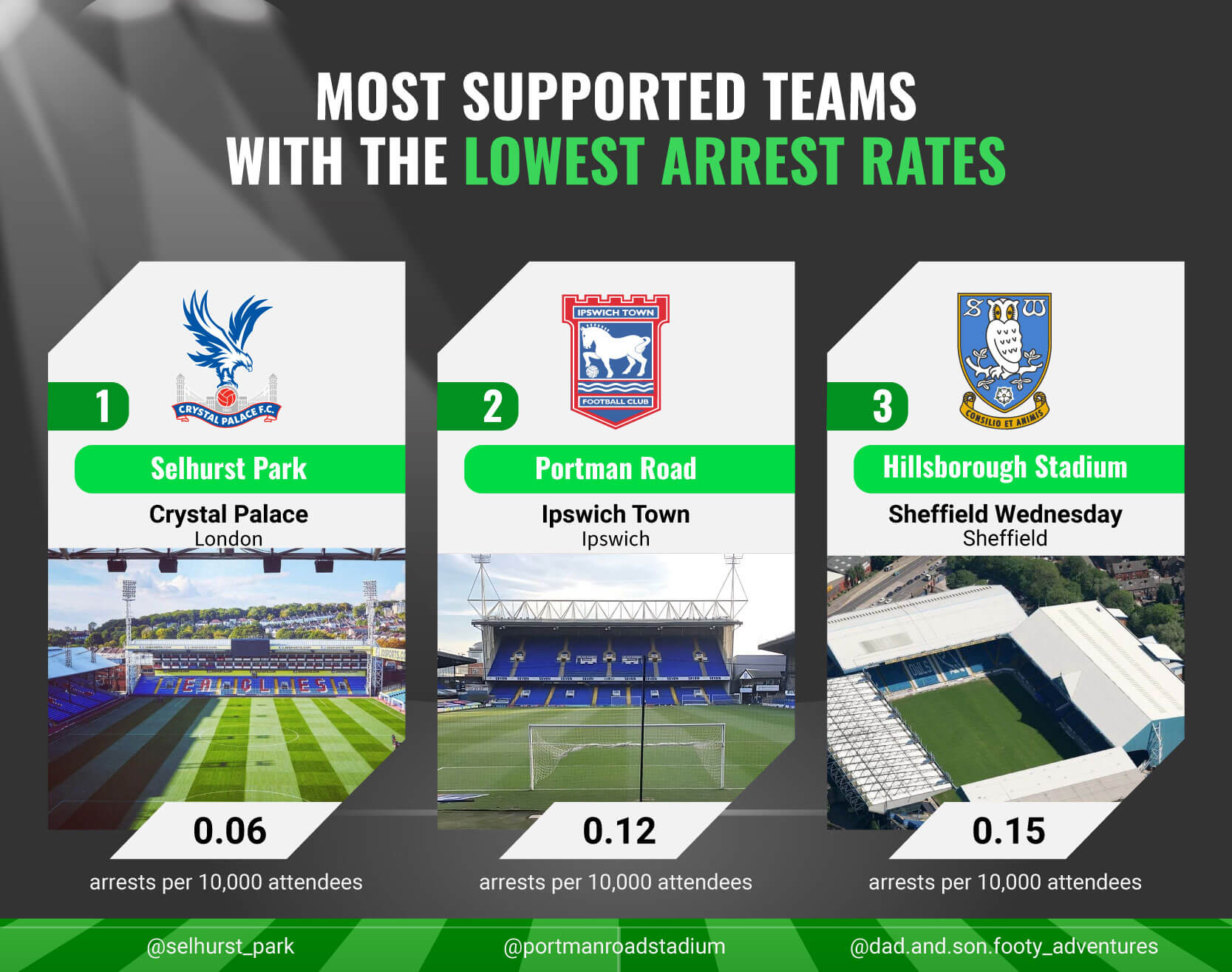
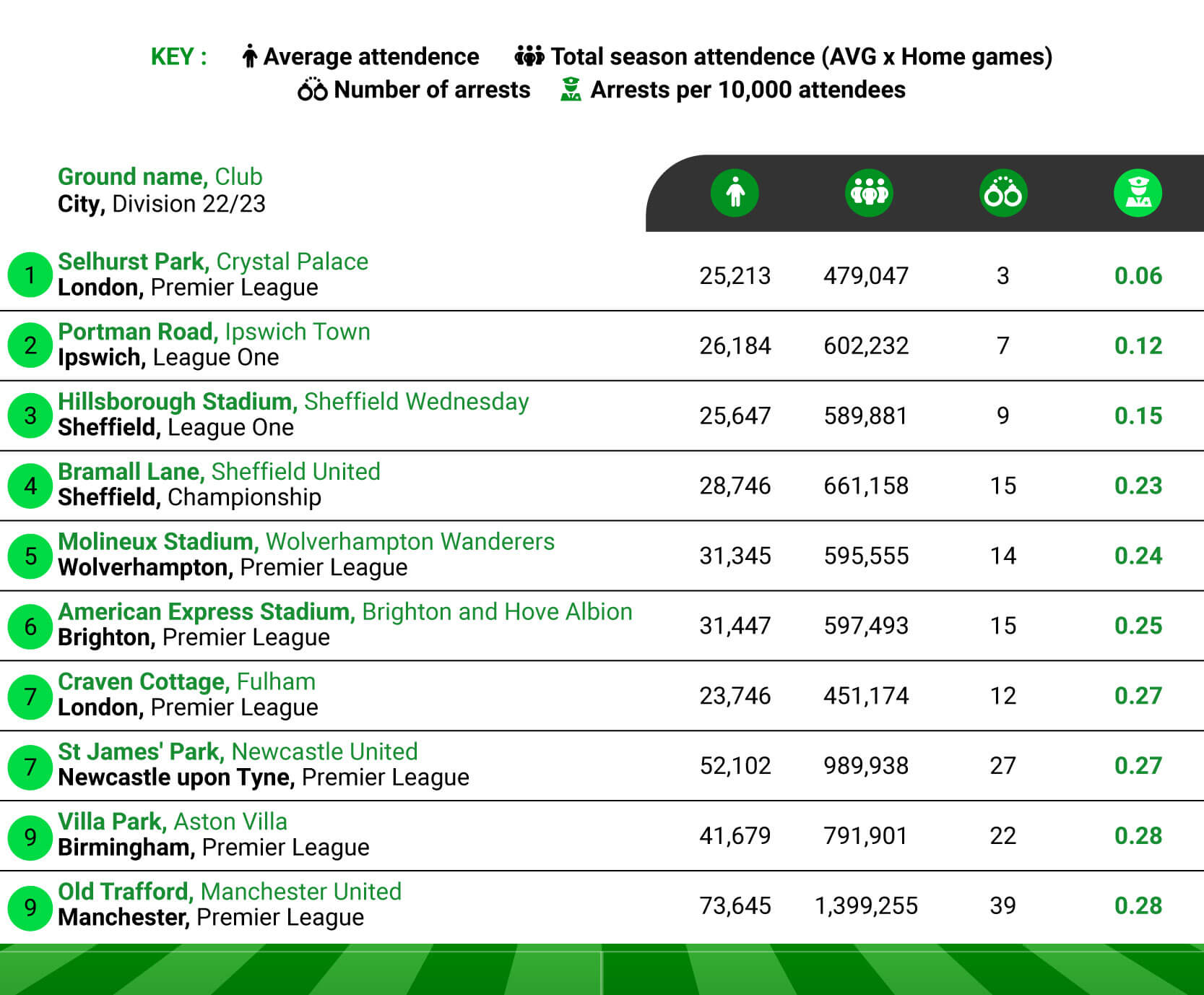
Selhurst Park (Crystal Palace) - 0.06 Arrests per 10,000 Supporters
Crystal Palace narrowly made it into the top 25 most supported clubs based on attendance during the 2022/23 season. It was another Premier League season for The Eagles, who finished eleventh despite relegation fears earlier in the year.
Patrick Vieira was sacked, and veteran manager Roy Hodgson returned, leading to an upsurge in results and a surprising shift towards attacking football, with players like Eze, Olise, and Zaha showcasing flair. With only 0.06 arrests per 10,000 supporters, Selhurst Park ranks among the safest football stadiums.
Portman Road (Ipswich Town) - 0.12 Arrests per 10,000 Supporters
Ipswich Town has seen a rapid rise in recent seasons, moving from League One to the Premier League in just two years. During 2022/23, The Tractor Boys finished 2nd, securing promotion.
The average attendance at Portman Road was just over 26,000, with seven arrests made during the season, resulting in 0.12 arrests per 10,000 supporters — a solid indicator of its safety.
Hillsborough Stadium (Sheffield Wednesday) - 0.15 Arrests per 10,000 Supporters
Sadly, Hillsborough Stadium is associated with one of the greatest tragedies in English football history, where 97 Liverpool fans lost their lives in 1989. In response, significant steps were taken to enhance football stadium safety.
In 2022/23, Sheffield Wednesday enjoyed success, securing promotion back to the Championship via the play-offs. Despite averaging only 25,000 fans in a stadium with almost 40,000 capacity, there were only nine arrests, or 0.15 per 10,000 fans, making it one of the safest football grounds.
Most Dangerous Football Stadiums in The UK
Weston Homes Stadium: The Most Dangerous in English Football with 3.04 Arrests per 10,000 Supporters
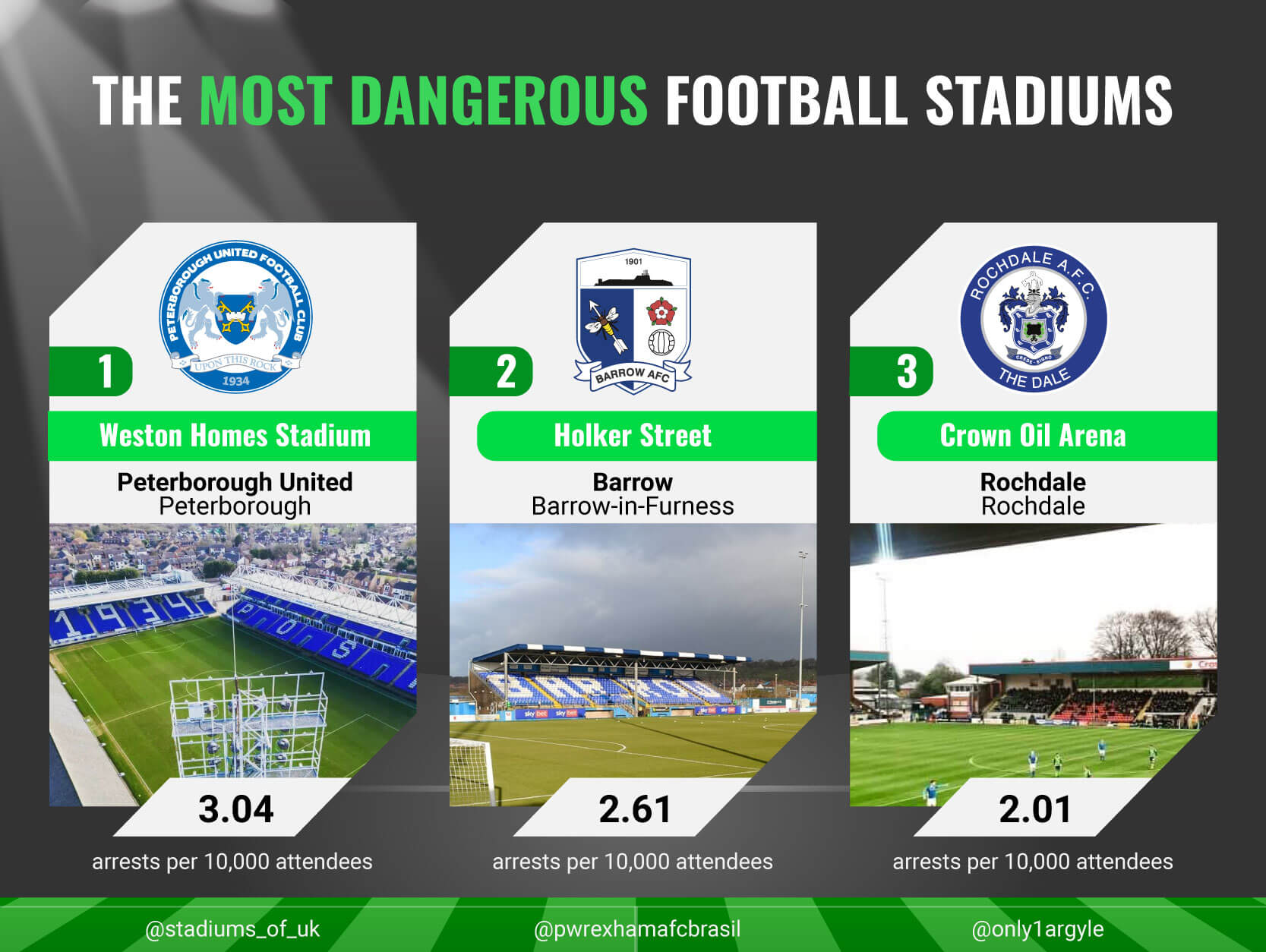
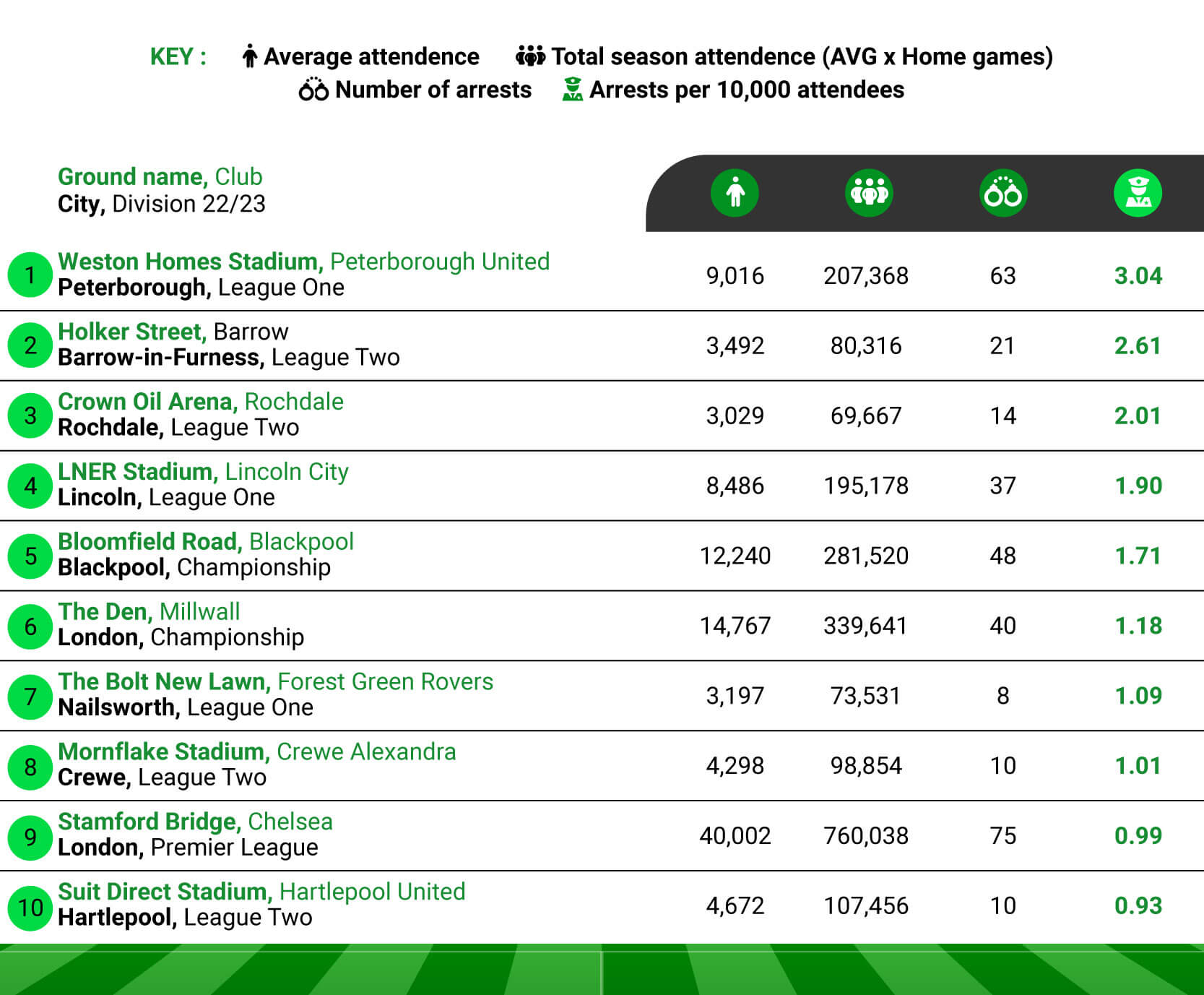
Weston Homes Stadium (Peterborough United) - 3.04 Arrests per 10,000 Supporters
Peterborough United's stadium is the most dangerous to visit in terms of arrests. The average attendance at London Road during the season was just over 9,000, with 63 arrests made as The Posh finished sixth in League One.
The season wasn’t smooth on the pitch, as manager Grant McCann left halfway through, replaced by Darren Ferguson. Despite managerial changes, badly behaved fans contributed to the high number of arrests, making it the most dangerous football stadium in the UK.
Holker Street (Barrow) - 2.61 Arrests per 10,000 Supporters
Barrow is a unique club in the football league, having to move out of their hometown for success. Despite travelling to play matches at Holker Street, the team trains in Manchester, attracting a higher calibre of players due to challenges in convincing them to move to the remote town.
Barrow-in-Furness has a reputation for being a tough town, and this is reflected in the number of arrests at the stadium. There were 21 arrests throughout the season, with an average attendance of just under 3,500 per game, making it one of the most dangerous football grounds in the UK.
Crown Oil Arena (Rochdale) - 2.01 Arrests per 10,000 Supporters
Crown Oil Arena, better known as Spotland, has been Rochdale's home since 1907, and the ground itself is even older.
Sadly, for Rochdale fans, 2022/23 saw them relegated out of the Football League after finishing at the bottom of League Two. In the stands, frustration turned into anger, resulting in 14 arrests, equating to just over two per 10,000 supporters.
Most Supported Teams With The Highest Arrest Rates
Of the Top 25 Most Supported Teams, Stamford Bridge Had the Most Arrests at 0.99 per 10,000 Supporters
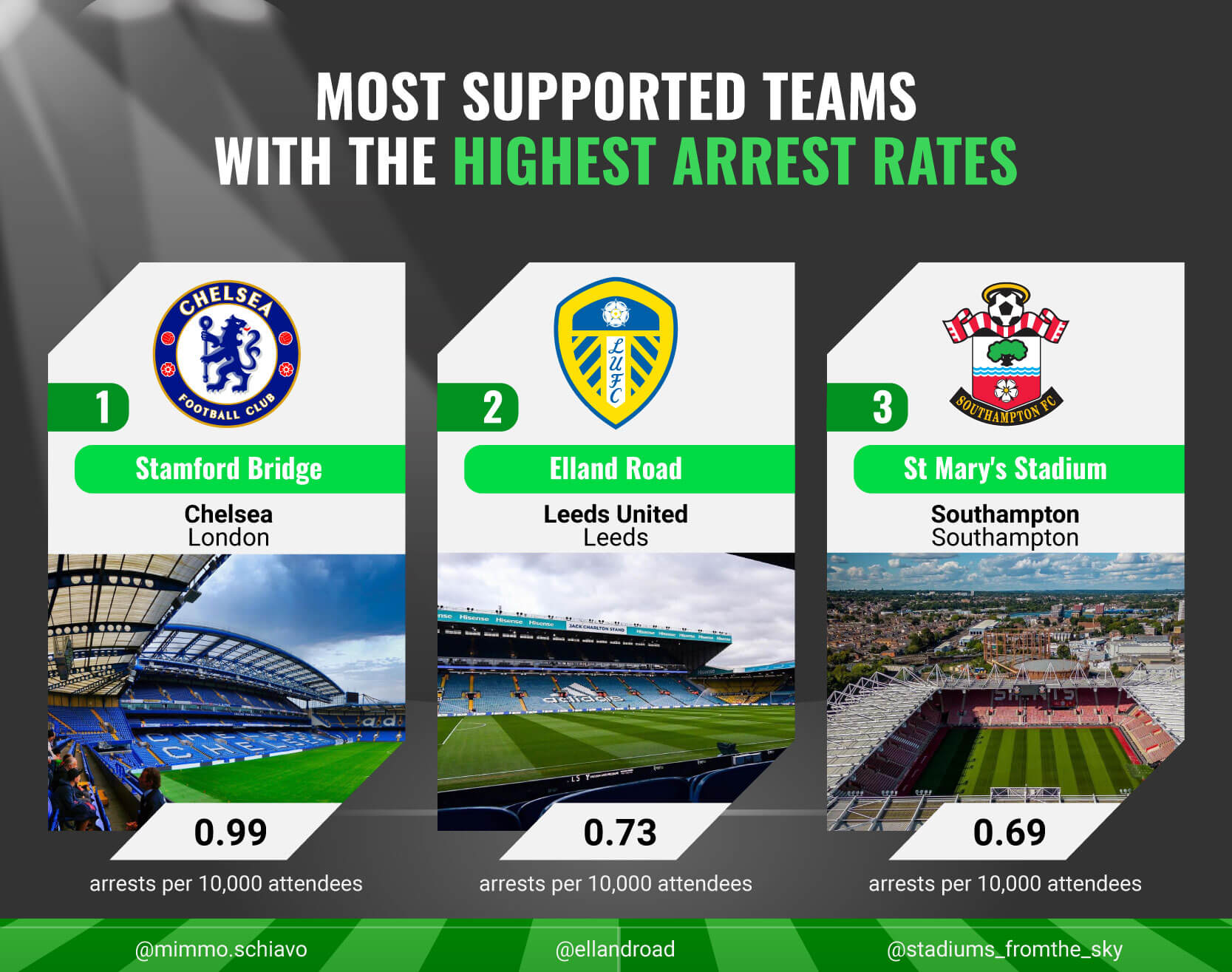
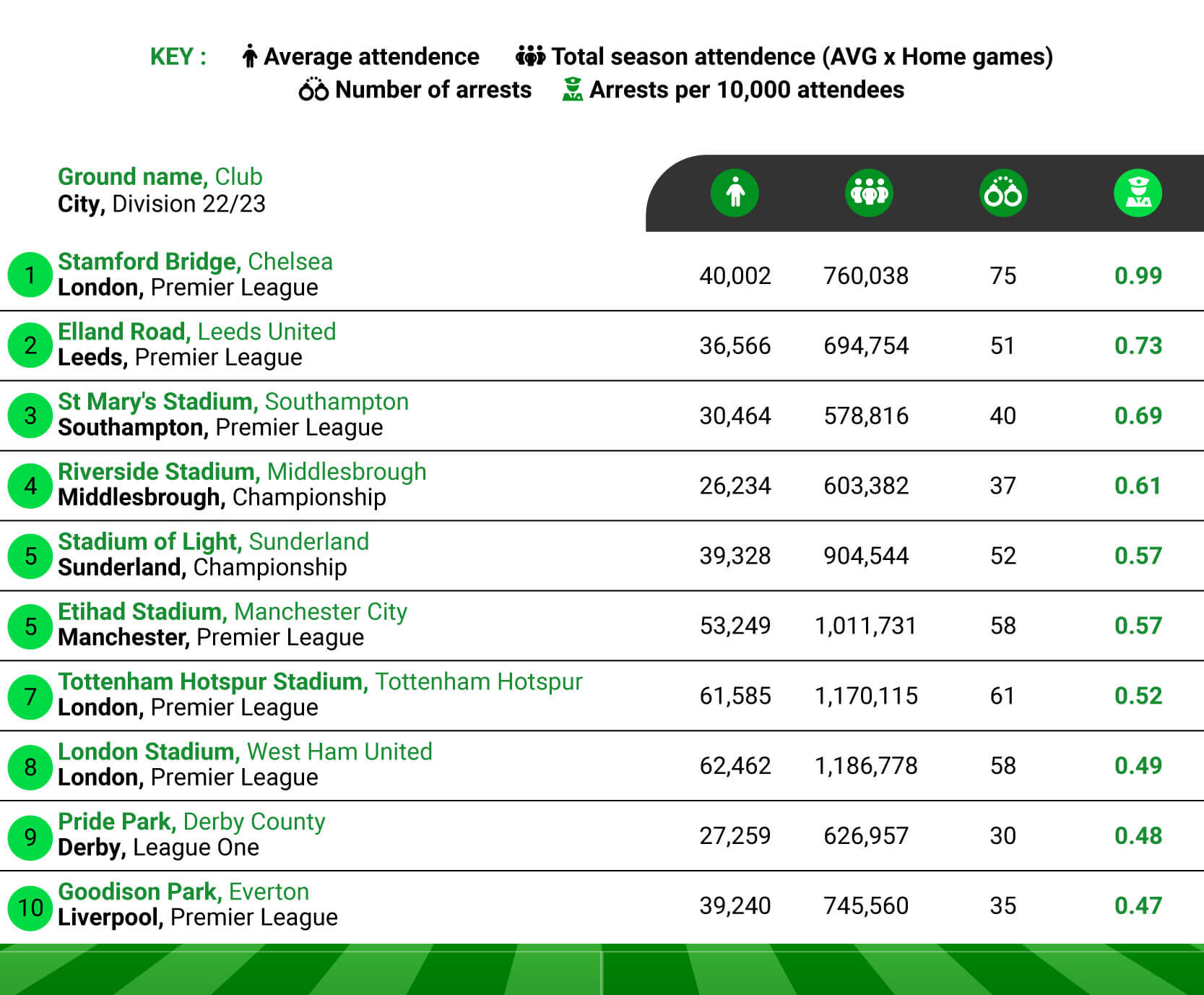
Stamford Bridge (Chelsea) - 0.99 Arrests per 10,000 Supporters
Stamford Bridge is another old stadium with a long history. Chelsea have called it home since 1905, and it has seen extreme highs and lows.
Despite a disastrous 2022/23 season on the pitch, with Chelsea going through multiple managers and finishing outside European places, fans still turned out in numbers. Unfortunately, there were also 75 arrests, making Stamford Bridge one of the most dangerous football stadiums in terms of arrests.
Elland Road (Leeds United) - 0.73 Arrests per 10,000 Supporters
Elland Road is synonymous with Leeds United and is known for its hostile atmosphere towards opposition teams. The Leeds faithful are some of the most passionate fans in the country.
In 2022/23, the club was relegated from the Premier League just two years after their return. The frustrations of fans were evident, with 51 arrests, equating to 0.73 per 10,000 supporters, making it one of the more dangerous football grounds.
St Mary’s Stadium (Southampton) - 0.69 Arrests per 10,000 Supporters
St Mary’s Stadium has been Southampton’s home since the early 21st century, replacing The Dell.
The 2022/23 season was disappointing for Southampton, resulting in relegation from the Premier League. This frustration was reflected in the stands, with 40 arrests made, or 0.69 per 10,000 supporters.
Most Supported Teams With The Lowest Rates of Banning Orders
Four teams claim the title of having the fewest banning orders out of the most supported teams, with only 0.03 each for every 10,000 attendees.
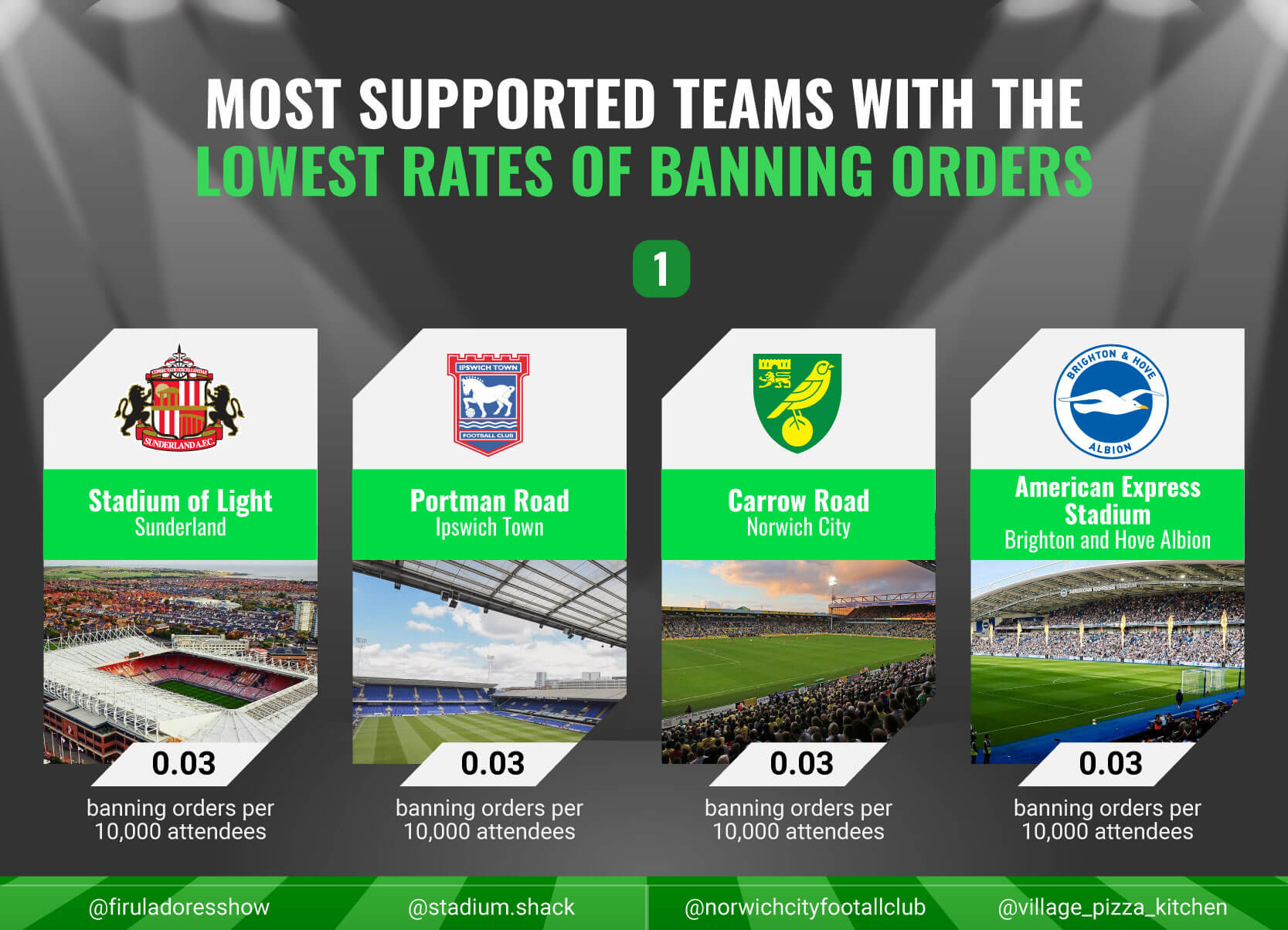
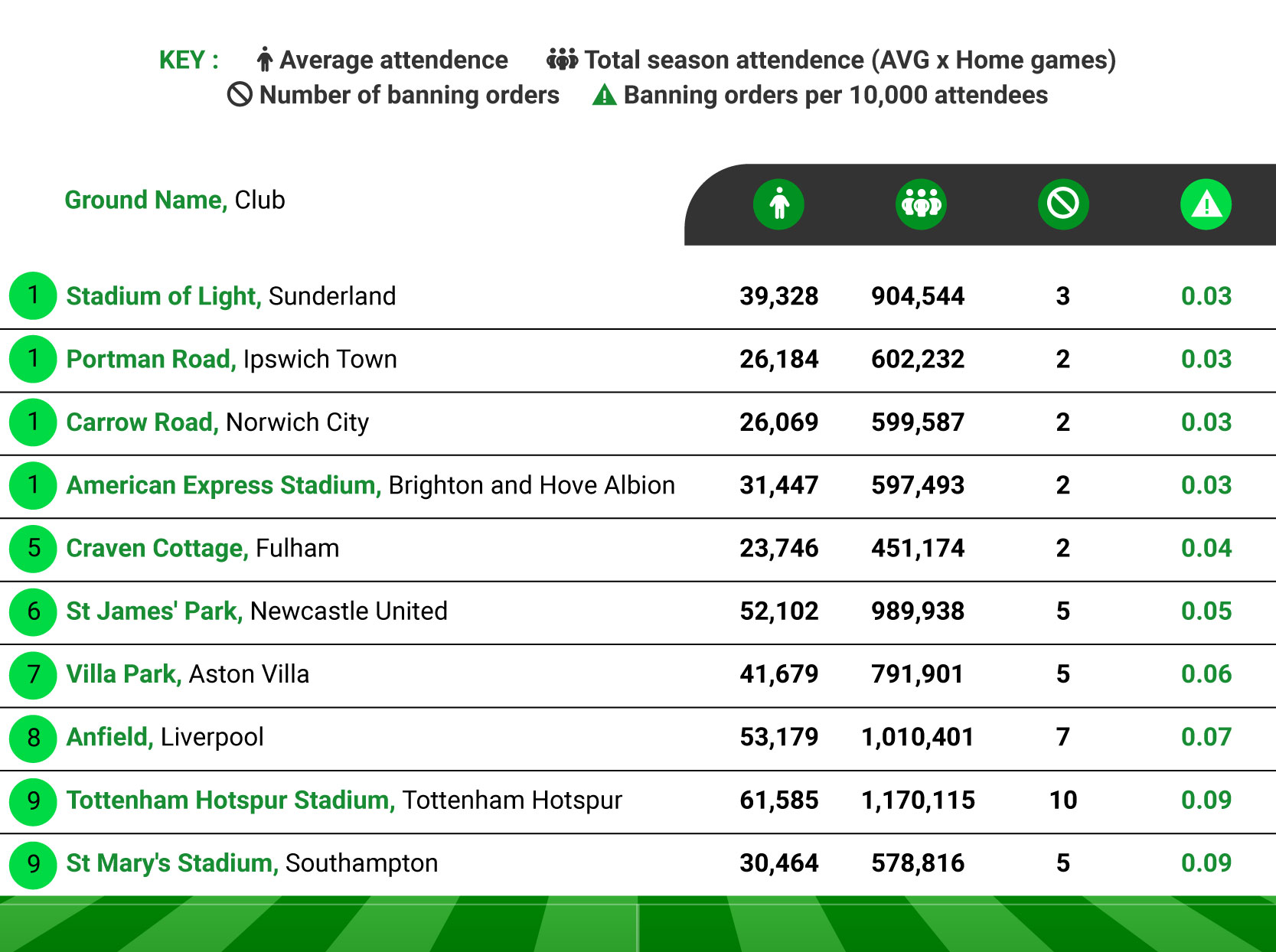
Stadium of Light (Sunderland), Portman Road (Ipswich Town), Carrow Road (Norwich City), and American Express Stadium (Brighton and Hove Albion) - 0.03 Banning Orders per 10,000 Supporters:
These four football stadiums have the joint lowest number of banning orders per 10,000 fans during the 2022/23 season. Despite playing in the Championship, Sunderland averaged almost 40,000 fans per game at the Stadium of Light, with only three fans receiving banning orders. The other three stadiums — Portman Road (Ipswich Town), Carrow Road (Norwich City), and American Express Stadium (Brighton and Hove Albion) — only had two supporters banned each, but they also had fewer fans attending their matches.
Most Supported Teams With The Highest Rates of Banning Orders
Riverside Stadium Recorded 0.38 Banning Orders per 10,000 People - Highest in the Country
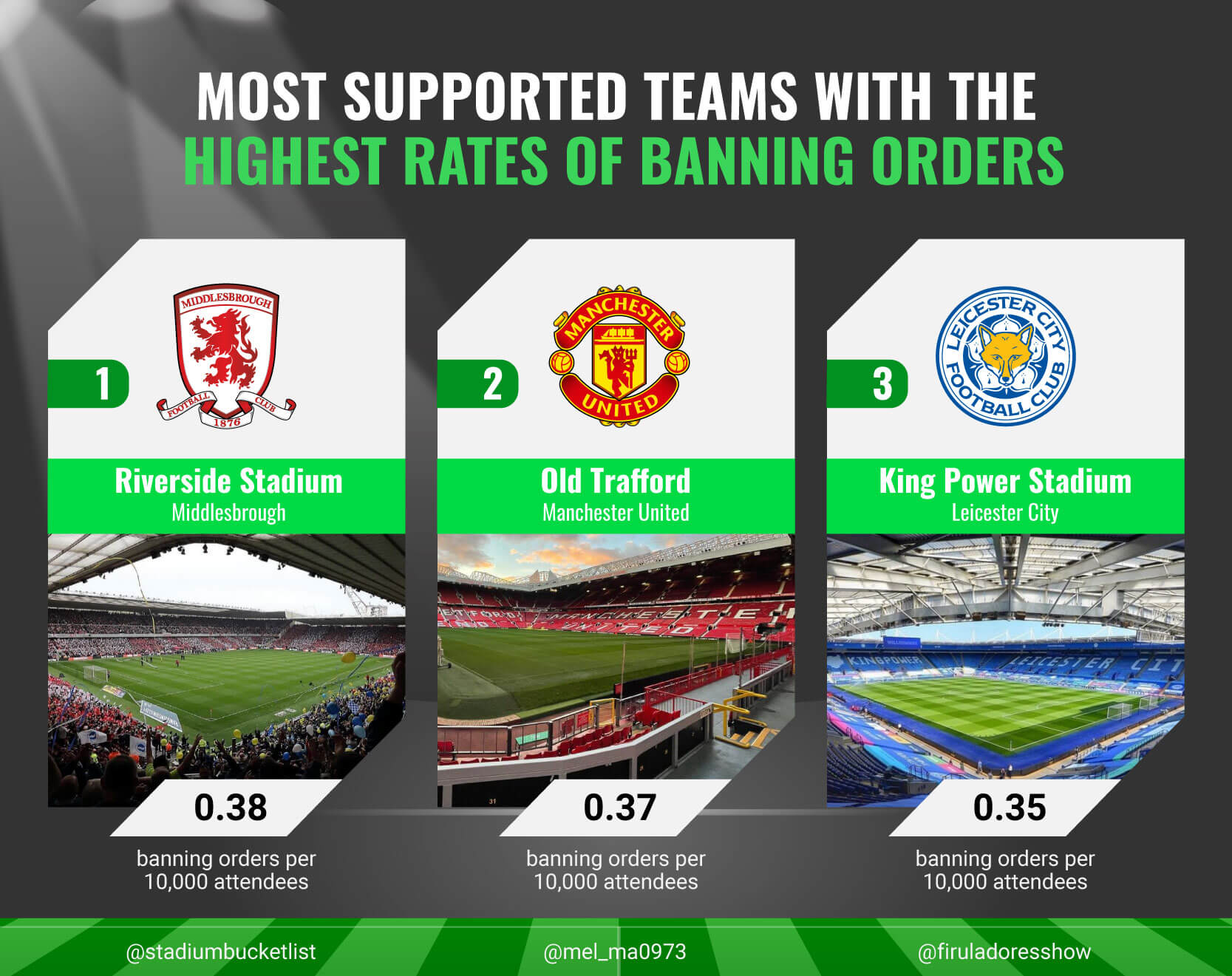
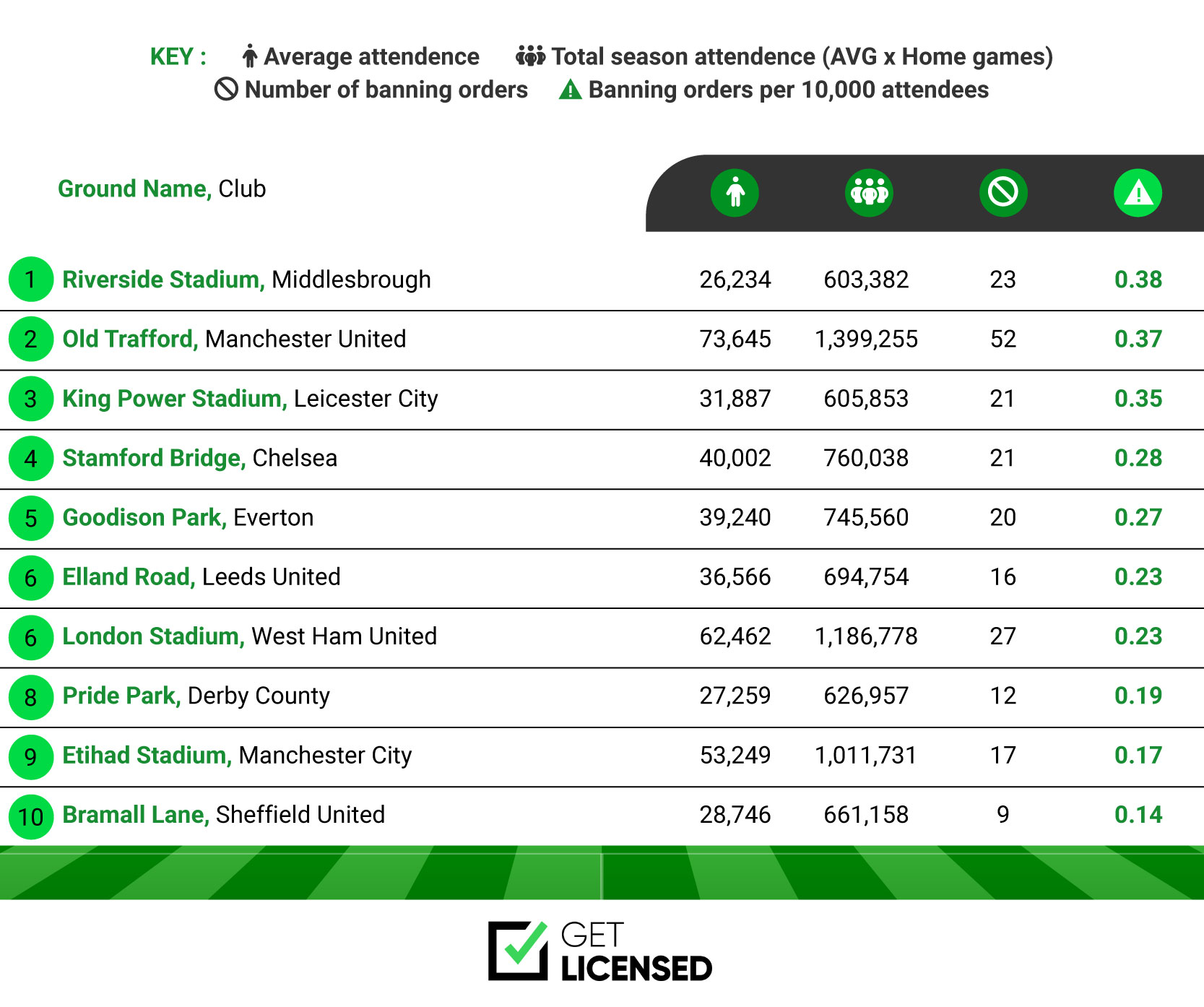
Riverside Stadium (Middlesbrough) - 0.38 Banning Orders per 10,000 Supporters:
Championship side Middlesbrough has called the Riverside Stadium home since 1995, and since then, Boro have experienced both highs and lows. In the 2022/23 season, they averaged just over 26,000 fans per game, with 23 banning orders issued — that’s 0.38 per 10,000 supporters, making it the football stadium with the most banning orders in the UK.
Old Trafford (Manchester United) - 0.37 Banning Orders per 10,000 Supporters:
One of the most iconic grounds in world football, Old Trafford, is the “Theatre of Dreams” and home to Manchester United. In recent years, the football stadium has been showing signs of wear, mirroring the team’s inconsistent performances. As a result, discussions are ongoing about building a new 100,000-seat stadium.
In the 2022/23 season, Manchester United had a decent first year under Erik ten Hag. However, off the field, there was disruption and protests against the club’s ownership, leading to 52 banning orders, or 0.37 per 10,000 supporters, making Old Trafford one of the most dangerous football stadiums in terms of banning orders.
King Power Stadium (Leicester City) - 0.35 Banning Orders per 10,000 Supporters:
The King Power Stadium was the scene of one of the greatest achievements in English football history when Leicester City won an unlikely Premier League title in 2016. The celebrations after one win even reportedly caused a minor earthquake around the football stadium.
Unfortunately, in the 2022/23 season, Leicester City was relegated to the Championship, resulting in frustration and anger from fans. This frustration is reflected in the number of banning orders handed out — 21 in total, or 0.35 per 10,000 supporters, ranking it among the most dangerous football grounds in the country.
How to Stay Safe When Attending Football Events
Whether you regularly attend football matches or are planning to go for the first time, there are steps you can take to ensure football match safety in and around the stadium:
1. Arrive Early and Stay in Groups:
If you arrive too close to kick-off time, you’re more likely to end up in a crowd, which increases the risk of trouble and pickpocketing. Football stadium safety starts with getting there early, sticking with friends or family, and securing all belongings.
2. Plan Your Transport in Advance:
Roads around football stadiums on match days are notoriously busy, and parking spots fill up fast. Luckily, there are usually plenty of transport options around bigger football grounds. By planning ahead, you lower the risk of getting stuck in large crowds or ending up in unfamiliar areas.
3. Know Stadium Rules:
Stadium rules can vary, so familiarise yourself with them before attending the match. These can include fire exit plans, standing area regulations, and prohibited items, all crucial for football stadium safety.
4. Look After Yourself:
It’s easy to get caught up in the atmosphere and forget to look after yourself at football matches. Stay safe by eating and drinking enough — especially on sunny match days!
5. Respect the Stadium Staff:
Security guards and football stewards are there to ensure everyone's safety. Many of these professionals undergo extensive SIA training to handle large crowds and maintain order during events. Always listen to their instructions and ask them if you’re unsure about anything.
Following these tips can help you stay safe during your next football match and ensure you enjoy the game to the fullest — whatever the outcome.
Methodology
We used Government data to find the total number of arrests during league games at each football stadium for the most recent year of study, 2022/23. We included arrests of both home and away fans, as these occurred at the stadium regardless of which team they were supporting.
We then used another Government dataset to find the number of banning orders by the club as of the 2022/23 season.
We used Football Web Pages to find each club's average attendance and multiplied it by the total number of home league games to determine the total number of supporters.
Finally, we calculated the number of arrests and banning orders per 10,000 fans attending.
Launch your career as a
Security Guard in the UK
Learn how to start your career in UK security industry.
Explore Courses

 Trustpilot
Trustpilot






























